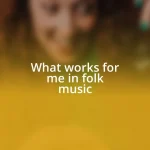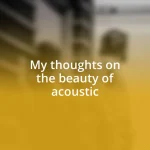Key takeaways:
- First encounter with jazz sparked a deep emotional connection, revealing it as a powerful storytelling medium beyond spoken words.
- Exploration of key jazz artists and genres enhanced understanding and appreciation of jazz, highlighting its diversity and emotional depth.
- Engagement with the jazz community fostered friendships and creative expression, culminating in personal growth and memorable musical experiences.

My first experience with jazz
I still vividly remember my first encounter with jazz on a rainy Saturday afternoon. I stumbled into a small café with a cozy vibe, the kind of place that seems to wrap you in a warm hug. As I sat down, the sound of a saxophone filled the air, weaving through my thoughts like a soft breeze.
The musician was lost in his craft, and I found myself captivated. I could almost feel the emotions swirling around me—the joy, the sorrow, the bittersweet moments of life. I couldn’t help but wonder, how could music express what words often fail to convey? In that moment, I realized jazz wasn’t just notes played on an instrument; it was a language of its own, telling stories that resonated deep within me.
As the melodies danced around the room, I found a sense of freedom and spontaneity in the music. I remember thinking, why hadn’t I discovered this earlier? It was as if each chord struck a chord within my soul, inviting me to explore uncharted emotional territories. That day, I didn’t just listen to jazz; I felt it, and it sparked a fascination that would grow to define my musical journey.

Discovering key jazz artists
Uncovering the pivotal artists of jazz was like peeling back the layers of a beautiful, complex flower. Each musician brought something unique into my world, illuminating my understanding of the genre. I still remember finding myself lost in the melodies of Louis Armstrong and his enchanting voice, which immediately resonated with my spirit, making me feel as though he was sharing a personal story with me.
Key Artists You Should Discover:
– Louis Armstrong: His trumpet mastery and vocal charm introduced me to jazz’s joyful side.
– Duke Ellington: The sophistication of his compositions redefined what I understood about orchestration in jazz.
– Miles Davis: With albums like Kind of Blue, he pulled me into the vast, innovative possibilities of jazz improvisation.
– Billie Holiday: Her emotive voice and poignant lyrics opened my eyes to the narrative depth of jazz.
– John Coltrane: I was astounded by his spiritual approach to jazz improvisation, which struck a deep chord in my heart.
Each artist I encountered had an unspoken dialogue with the emotions I hadn’t yet verbalized. Their music stirred something within me, pushing me to explore more deeply not just into jazz but into my own feelings and experiences. It’s fascinating how these sonic treasures connected me to a wider world, making me feel part of an ongoing conversation woven through time and culture.

Exploring different jazz genres
Jazz is an incredibly diverse genre, boasting a range of styles that offer unique listening experiences. From the soulful resonances of blues-infused jazz to the upbeat tempos of bebop, each subgenre tantalizes the senses in its own way. I remember being particularly moved by smooth jazz during a late-night drive. The soothing melodies wrapped around me, weaving a serene atmosphere that felt like a gentle hug, inviting deep reflection and peace amidst the hustle of life.
As I explored further, I was struck by how traditional New Orleans jazz embodied a communal spirit, making you feel like you were part of a lively street party. I recall attending a local festival where brass bands filled the air with joyous sounds that compelled everyone to dance. It was exhilarating to witness musicians feeding off the energy of the crowd, creating an atmosphere of pure celebration. The rhythm and improvisation sparked a joy within me that I hadn’t experienced in quite some time.
To deepen your understanding of various jazz genres, the following table outlines key characteristics and examples:
| Jazz Genre | Key Characteristics |
|---|---|
| Traditional Jazz | Originating from New Orleans, known for collective improvisation and lively rhythms. |
| Bebop | Fast tempo, complex chord changes, and focused on individual virtuosity and improvisation. |
| Cool Jazz | Relaxed tempos and lighter tone, emphasizing a smooth and sophisticated style. |
| Fusion | Combines jazz with rock, funk, and world music, creating innovative soundscapes. |
| Avant-Garde Jazz | Experimental and free-form, pushing the boundaries of traditional jazz structures. |

Attending live jazz performances
Attending live jazz performances was a transformative experience for me. I still vividly recall stepping into a cozy jazz club one rainy evening, the low lighting and intimate setting instantly creating a hushed anticipation. As the first notes from the saxophone sliced through the air, I felt an inexplicable connection, as though the music was wrapping around me like a warm blanket. How could something so spontaneous create such profound emotions?
I remember being captivated by the way musicians would interact with one another on stage. There’s a certain energy that comes alive during a live show, where each note played feels like a conversation between artists. Watching a drummer seamlessly sync with a bassist created an almost electric atmosphere that no recording could replicate. I found myself nodding along, feeling every beat resonate with my heartbeat. Can you recall a moment when music made you feel truly alive?
In those moments, jazz became more than just a genre—it transformed into an experience that stirred my soul. I can still picture the delightful chaos of a jam session, where musicians took turns improvising, pushing the boundaries of creativity. One night, I experienced the thrill of a spontaneous musical exchange; it was as if they were sharing their innermost thoughts and emotions right in front of me. This is where I truly fell in love with jazz—it’s not just about the sound; it’s about connection, expression, and the beautiful conversations that can happen between artists and their audience.

Learning to play jazz music
Learning to play jazz music was a journey that opened up a whole new world for me. I remember the first time I picked up a saxophone, feeling both excitement and trepidation. The notes soared and swirled around me, a musical language that felt almost like a conversation—it was exhilarating, yet humbling. Have you ever felt a thrill from trying something entirely new, uncertain yet eager?
In my practice sessions, I often found myself lost in the art of improvisation. There’s something magical about letting go of the sheet music and allowing your emotions to guide you. One evening, after hours of playing, I stumbled upon a melody that reflected my joy and sadness all at once. It was as if the saxophone became an extension of my feelings. Isn’t it incredible how music can express what words sometimes cannot?
As I delved deeper into this genre, I realized that mastering jazz wasn’t just about technique but understanding the heart of the music. Jamming with fellow musicians taught me the importance of listening and responding—being present in the moment. Those late-night sessions, filled with laughter and spontaneous musical exchanges, created bonds like no other. I still cherish those memories, as they captured the essence of jazz: collaboration, understanding, and the freedom to express oneself. Isn’t that what we all seek—a connection through our passions?

Connecting with the jazz community
It wasn’t long after I started playing jazz that I began to seek out a community that shared my passion. One chilly evening at a local cafe, I saw a flyer for a jazz workshop and thought, “Why not?” That simple decision led me to a gathering of like-minded musicians, where we exchanged ideas and honed our skills. I’ll never forget the sense of belonging I felt; it was like discovering a hidden family united by rhythm and melody.
As I spent more time in the jazz scene, I realized how important these connections were. I attended an open jam session, and I still remember how the nervous energy in the room transformed as musicians took turns showcasing their talents. The atmosphere was electric, and I felt a surge of pride when the group welcomed me to share my first solo. Wasn’t it exhilarating to have that moment of acceptance, where vulnerability turned into a celebration of creativity?
Engaging with the jazz community has not only enriched my understanding of music but also forged lasting friendships. I think back to one unforgettable night beneath the stars at a jazz festival, surrounded by fellow enthusiasts. We danced, laughed, and lost ourselves in the music, immersed in a collective joy that was palpable. In that moment, I realized that jazz is a language of connection—it draws people together, allowing us to celebrate life’s highs and lows. Isn’t it wonderful how music can bridge gaps, create memories, and deepen our connections with others?

Creating my own jazz playlist
Creating my own jazz playlist was like curating a soundtrack to my life. I started by grabbing a notebook, jotting down the names of songs that resonated with me. Each track was a piece of my journey—some were vibrant and upbeat, while others were slow and soulful, mirroring my emotions at different moments. Have you ever felt the thrill of piecing together memories in a single playlist?
As I explored, I took the time to dive into each artist’s story. Discovering their backgrounds added depth to my selections. I can still recall the joy of including John Coltrane’s “A Love Supreme.” It felt personal, almost as if I was sharing a secret with my listeners. Isn’t it fascinating how music can encapsulate complex feelings, transporting us through time and space with just a few notes?
Over time, the playlist evolved, much like my understanding of jazz. With each modification, I found myself revisiting those initial emotions and memories, allowing them to shape the musical experience. Sometimes, I’d even sit in silence, headphones on, fully immersed, as the melodies took me on an adventure I didn’t want to end. I wonder: how does your favorite playlist reflect your journey?















